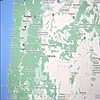HOME | DD
 AustinSPTD1996 — Looking To the Fleets
AustinSPTD1996 — Looking To the Fleets

Published: 2023-09-14 15:32:50 +0000 UTC; Views: 447; Favourites: 2; Downloads: 1
Redirect to original
Description
Be sure to read the description before commenting below.Well, it's Thursday and today I felt like engaging in the cliché of "Throwback Thursday" by showing a couple older photos of past trips. Back in July of 2022, I accompanied my mom and sister on a trip to Newport, the flagship city of Lincoln County. We spent some of our daytime in the city's Historic Bayfront District, home to a number of tourist shops and restaurants like Local Ocean Seafood and a Made In Oregon store to name a few. It also provides broad views of some of the fishing vessels along the harbor, along with information on some of the fishery species sought for and practices used in Oregon's seafood industry. Based on the design, the ship in the center here appears to be a salmon troller. There are ships for other marine animals like Dungeness crabs and Pacific pink shrimp among others.
While some people may feel differently, I do think this is a pretty cool display of some of the fishing vessels present at Newport's bayfront. It feels more comforting to observe the fleet knowing Oregon's fisheries employ sustainable management practices to minimize impacts on marine life. Oregon's seafood industry is one of the best-managed in the world and some of the species sought after are quite delicious too. It simply felt impressive to observe some of the ships (and crew members) that go through challenging work to help deliver some of Oregon's most iconic seafood items to stores and restaurants -- and with some relatively peaceful coastal scenery in the background to boot. ^^
--------------------------
If you don't mind, here's some information on some of the vessels in the bay.
The salmon ships go for Chinook and Coho salmon by towing lures or baited hooks through the water. Fishing lines are attached to a pair of outriggers or trolling poles. When lowered, they hold the fishing lines away from the boat. Since this doesn't involve nets, it allows fishers to target specific species found at certain depths, thereby reducing bycatch of unintended species. The season normally runs April through October. Salmon are caught one at a time, immediately cleaned, and packed in ice. When back in port, the fishes are delivered to a processor for shipping preparation and distribution, or sold directly to markets and restaurants. Some fishers also have permits to sell directly to the public.
Salmon fishing is regulated by state and federal managers. Each year, open seasons and quotas are established by estimating the number of returning adults traveling to spawn. This helps ensure that the harvest of the resource is balanced with long term sustainability.
The shrimp vessels tow two small-meshed (1.5 in mesh size) nets just above the ocean floor to catch small, pink cocktail shrimp. The season runs April through October. An outrigger on each side of the vessel is lowered to tow the nets. Nets are towed at depths of 240-900 feet for around 60-90 minutes. A set of doors, attached to each net, holds the net open while it's being towed. Nets make use of a device called a grate to allow rockfishes and halibut to slip out. Once on board, the shrimp are emptied from the net into an aluminum hopper that sorts the shrimp. The crustaceans are then transferred into the fish hold and immediately iced. Back at the port, the shrimp go through processing an elaborate cooking and peeling process. After processing, they are shipped fresh or frozen to retailers and food service markets across the U.S. and overseas.
The Oregon shrimp fishery is among the cleanest in the world. Sound management practices along with bycatch reduction devices, have made Oregon's pink shrimp fishery the first shrimp fishery to earn Marine Stewardship Council certification for its commitments to sustainability.
The crab vessels make use of baited traps or pots to catch Dungeness crabs. They are allowed to drop traps into the water on November 28 for a "presoak." Traps are baited with squid, clams, or fish carcasses for crabs to scavenge on, and dropped in depths of 20-500 feet. They are pulled and emptied every few days. Most traps are circular, measuring 3 to 4 feet across and weighing 75 to 120 pounds. Crabs enter the trap through openings on the sides. Smaller openings on the trap enable undersized crabs to escape. Additionally, a section of the top panel is fastened with biodegradable twine called rotten cotton. If the trap is lost, the twine will deteriorate in 60-90 days, allowing any remaining crabs inside to escape. Live crabs are delivered to processors, who cook, clean and sell them to the retail market. Some fishers will also sell directly from their boat.
More Dungeness crabs are landed in Newport than anywhere else. It's Oregon's highest-valued seafood product , with an average value of $29 million annually. The fishery, dating back to the late 1800s, is managed by the Oregon Department of Fish and Wildlife using the three S's: size, sex, and season. In commercial harvest, only male crabs with a carapace size of 6.25 in across or larger can be harvested between December 1 and August 15. Enough mature males remain to mate with females (state law requires all female crabs to be released unharmed), helping maintain a sustainable fishery.
Information came from plaques posted by officials from the Oregon Coast Aquarium, the Port of Newport and others.

















